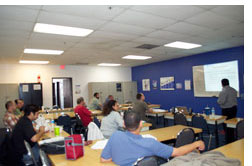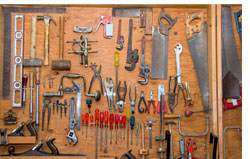Available Courses
-
CSLB Exam Prep Classes
- In-School Law & Trade
- Law & Business Online
- Home Study Law & Trade
- Crash Course
- Test Taking Skills
- Construction Math Review
-
Seminars & Continuing Ed
- Blueprint Reading Seminar
- California Electrical Cert.
- EPA - RRP Certification
- Mold Remediation
- Home Inspection Course
- ICC Certification
-
- Online Practice Exam for CA State License Exam
- Online Companion Guides for CA State License Exam
- TRY NOW! Online Practice Exam Demo
-
Clases de Español
-
Contractor Business Services
- Meet our Instructors
- Online Store
Newsletter

CSLS Construction Connection
Contractors State License Services is committed to the continued growth and education of your career as a licensed contractor. It is our intention to provide you with valuable information of what's new in the construction industry, important events that you may want to attend, and helpful business and exam preparation tips. You can also stay connected with CSLS through Facebook, Twitter, LinkedIn and You Tube.IN THIS ISSUE
- The True Value of a Good Nail
- CSLS Introduces New Solar PV Technical Sales Course
- Where is yours?
- CSLS Honors Greg Daly with a Scholarship
- Leading The Way to a Safer World
- Words of Wisdom
- Referral Program
The True Value of a Good Nail
 The Nail is one of the most used fasteners in the building trade world-wide with an embedded reputation which spans the globe and is fodder for popular expressions, many of them shrouded in confusion and mystery.
The Nail is one of the most used fasteners in the building trade world-wide with an embedded reputation which spans the globe and is fodder for popular expressions, many of them shrouded in confusion and mystery.
‘Nailing down’ the frequent allusions and perplexities of nails is as easy as ‘nailing jelly to a wall’.
Describing nail size is a common quandary. Referring to a 6 penny or an 18d nail actually has nothing to do with its true size or cost. A 6 penny does not cost a penny and an 18d is not 18 inches long. The odd labeling originates from England where nails were priced by size per hundred. 100 2-1/2 inch nails might cost 16 pence where 100 1-1/2 inch nails might only cost 6 pence. The “d’ label is the symbol for ‘penny’ stemming from the Latin Denarius and the French Denier. The terms have endured and continue to confound the logic of labeling and perpetuate nail lore.
The idiom ‘hard as nails’ is its own riddle since copper nails voluminously used by British Navy Boat builders in the mid 1600’s are soft and malleable. Copper nails and their ability to ‘give’ and move with the motion of the ship’s planks and copper haul sheathing along with its natural resistance to rust and corrosion were the desired traits, not hardness.
“Hard as a bed of nails” doesn’t sound comfortable no matter how soft and pliable the nails. Contrary to assumptions however, a ‘bed of nails’ was not a device of torture. Ancient Indian mystics and Chinese scriptures alluded to the ‘healing’ properties of the spiked platform with claims it could cure physical ailments and produce clarity and balance of mind and body.
Ultimately, the true value of a good nail is not in its healing powers, but in its holding power.
Before the age of machines, nails were handmade one at a time; squared iron rods heated and hammered into a four edged tapered length sharpened to a point which easily penetrated the wood. Moisture, expanding the wood fibers, found footholds in the irregularities and defined edges of the superbly simple yet powerful fastener and created a holding power unrivaled even by today’s designs.
Blacksmiths fought ‘tooth and nail’ to keep up with demand. Nails were in such short supply and abandoned buildings were routinely burned to the ground in order to salvage the rare and costly small metal pins. Efforts to increase output were eventually successful and by the late 1700’s mass production of nails inspired architectural designs never thought possible and transformed the building trade.
Oftentimes change can be the virtual ‘nail in the coffin’ but the nail making machines using coil and producing smooth round shafted nails, despite having only a quarter of the holding power of hand hewn nails, were all the rave. The ease, affordability and availability of the nails created an expanded market for milled wood which was a boon for shipping and construction industries.
Thomas Morton, who invented the first American built wire nail machine ‘nailed it’.
An Old Proverb
For Want of a Nail
For want of a nail the shoe was lost.
For want of a shoe the horse was lost.
For want of a horse the rider was lost
For want of a rider the battle was lost.
For want of a battle the kingdom was lost
And all for the want of a horseshoe nail.
Nails are indispensible; with them we build our homes, businesses and dreams. They are through our walls, under our feet, in our shoes and on our minds. The invention of the nail has resulted in countless creations and an abundance of memorable expressions that ‘hit the nail on the head’.
CSLS Introduces New Solar PV Technical Sales Course
 Contractors State License Services (CSLS) has introduced a new Solar PV Technical Sales Course intended to teach the skills necessary to work as a salesperson in the growing solar industry. This course covers important sales skills combined with the technical information that are specific to a solar sales position. The course includes a comprehensive curriculum covering; mining for prospective customers, evaluating the needs of a PV System customer, the technicalities of site analysis and system selection, concept design, performance estimates, economic analysis, financial concepts, proposal formation and building a working relationship with your customers. Robert Srinivas the Regional Green Technology Training Manager at CSLS developed this program to help people in construction or sales related fields transfer their skills to this broadening industry. The first class was held at the CSLS Orange location on October 8th and 9th, 2011. Initial response to the class was very positive. Willy Littlefield, a Solar Sales student shared “Rob had a passion and depth of understanding in solar. I asked many challenging questions and all of my questions were answered fully”. Classes are planned to be held at Contractors State License School locations throughout California. For details on the course schedule interested contractors and sales professionals can contact the corporate offices at Contractor State License Services 800-331-4691.
Contractors State License Services (CSLS) has introduced a new Solar PV Technical Sales Course intended to teach the skills necessary to work as a salesperson in the growing solar industry. This course covers important sales skills combined with the technical information that are specific to a solar sales position. The course includes a comprehensive curriculum covering; mining for prospective customers, evaluating the needs of a PV System customer, the technicalities of site analysis and system selection, concept design, performance estimates, economic analysis, financial concepts, proposal formation and building a working relationship with your customers. Robert Srinivas the Regional Green Technology Training Manager at CSLS developed this program to help people in construction or sales related fields transfer their skills to this broadening industry. The first class was held at the CSLS Orange location on October 8th and 9th, 2011. Initial response to the class was very positive. Willy Littlefield, a Solar Sales student shared “Rob had a passion and depth of understanding in solar. I asked many challenging questions and all of my questions were answered fully”. Classes are planned to be held at Contractors State License School locations throughout California. For details on the course schedule interested contractors and sales professionals can contact the corporate offices at Contractor State License Services 800-331-4691.Where is yours?
 “Hey, watch out, don’t… ”
“Hey, watch out, don’t… ”
“Mom, I’m sorry...what do I…”
“Get the wrench so I can turn off the main. Hurry, Run”
Ten seconds later, “it’s not here”.
“Yes it is, look harder. Hurry”
Crying, “Mom, it’s not here…help me, what do I do?”
So I ran into the garage, searched through the tool chest and sure enough, nothing. I ran to the porch and looked in the bucket I sometimes toss my tools, not there. I ran to the other shed and looked…nothing. As the needle on the meter spun into a blur, I could see my water bill adding up the dollar signs. The front walkway was under 2 inches of water and I couldn’t find the stupid wrench.
Ten minutes later the main was shut off and the hunt for pipe remnants, pipe cutter, and PVC glue began. The entire fix which should have taken 15 minutes took 2 hours as I scrounged random tool boxes, drawers and nooks and crannies for the tools and parts I knew I had but couldn’t find and absolutely REFUSED to repurchase.
Rule of the tool: A place for everything and everything in its place.
How many times have you needed a particular tool or piece of equipment and spent hours looking for, or not found at all? The temptation to run to the hardware store and buy a new one is overwhelming, but the cost and waste can be astronomical.
Precious time spent rifling through tool boxes is also value lost. Your time, employee time, the cost of repurchasing, or even worse, compromising with an inadequate, but available tool or part…can ruin a job, be expensive and even dangerous. There is only one good solution: Put everything back where it belongs when you’re done. The few seconds it takes to return a tool to its place can save you hours of time, frustration and money. When emergencies happen, it is about the job, fixing the problem and not about the money. The result of not having your tools where they belong when you need them can easily result in undue hardship as well as economic loss.
I’m not alone in my bad habit of misplacing tools and companies are cashing in on people like me with ‘Tool box engineers’ who have come up with no-excuse storage. Tool storage has come a long way from peg boards with hooks and wooden boxes. Through technology and time, we now have robotized storage bins and computer software tracking; head-high tool boxes on wheels, magnetic bars and panels, even fashionable tool cabinetry with coordinated colors and choice of finishes. Nothing is too good for a good tool.
The only real secret to successful tool storage is you putting the tool back where it belongs immediately.CSLS Honors Greg Daly with a Scholarship
 Greg has been working in the construction industry for 22 years but like many in the construction industry has recently been laid off. With so much experience he has plenty of opportunities for work but needs his license to be able to work his own jobs. CSLS has awarded the In-School Law & Trade License Exam Preparation Program to Greg to help him get his General B License. With his license he is hoping to get back on track to continue to provide for his family and to keep thier home.
Greg has been working in the construction industry for 22 years but like many in the construction industry has recently been laid off. With so much experience he has plenty of opportunities for work but needs his license to be able to work his own jobs. CSLS has awarded the In-School Law & Trade License Exam Preparation Program to Greg to help him get his General B License. With his license he is hoping to get back on track to continue to provide for his family and to keep thier home.
Leading The Way to a Safer World
 Lead (Pb: Latin for Plumbum), overexposure is one of the leading causes of workplace illness.
Lead (Pb: Latin for Plumbum), overexposure is one of the leading causes of workplace illness.
The characteristics of softness, durability and intense pigmentation along with its low melting point and resistance to corrosion have made lead one of the leading metals in manufacturing and construction industries today. From plumbing to roofing to paints, lead is everywhere.
The wide use of leaded paints within the construction business is of major concern. The housing boom of the 40’s and 50’s saw the prolific use of leaded paints skyrocket. Unfortunately, as years passed and paint chipped reports of lead poisoning drastically increased prompting new legislation and regulation of lead based paints and their uses. When paint deteriorates and peels, it is easily ingested by small children and leaded dust can be inhaled by adults as well, presenting a dangerous living and work environment.
Unsuspecting children who play on lead-dust laden carpet or lead tainted dirt are most susceptible but homeowners and contractors who work on and around degraded leaded paint are also at risk; so much so that the EPA and OSHA have implemented regulations, controls and even fines to reduce further infestation of lead toxins into our bodies and the environment.
In 1977 under the Consumer Product Safety Commission Act, (16 Code of Federal Regulations CFR 1303) the U.S. Consumer Product Safety Commission (CPSC) took action to reduce the risk of lead poisoning by banning the application of lead-based paint in housing constructed or rehabilitated with federal assistance.
By the 1980’s a significant shift in lead use had taken place, much of it as a result of the U.S. lead consumer’s compliance with environmental regulations that eliminated the use of lead in products including water systems, gasoline, solders and paints. The devastating results of lead poisoning have taken their toll on families, healthcare and the courts. The U.S. Department of Housing and Urban Development (HUD), which facilitates housing for low income buyers, has been inundated by billions of dollars of lead poisoning lawsuits.
The current regulations and restrictions put on lead products and those who work with them are essential to help prevent further poisoning of our children, ourselves, and our planet. Since April 22, 2010, the US Environmental Protection Agency (EPA) requires that all renovators who work in homes built pre 1978 and disturb more than six square-feet of lead paint be trained and certified in safe handling, removal and disposal of Lead based paint.
Mining, processing, designing and building with lead has presented new products and advancements, now it presents another step in the process, cleaning up the mess. The costs, health and lives affected by lead toxins are devastating and it is up to knowledgeable homeowners and trained professionals to correct the problem and create a safer healthier world.
Words of Wisdom
“Believe you can and you're halfway there.”
~ Theodore Roosevelt
Referral Program
You can earn up to $50 through our Referral program for each referral you send that purchases one of our courses. Call for details on how to participate.
Call 888-900-2757 for details

